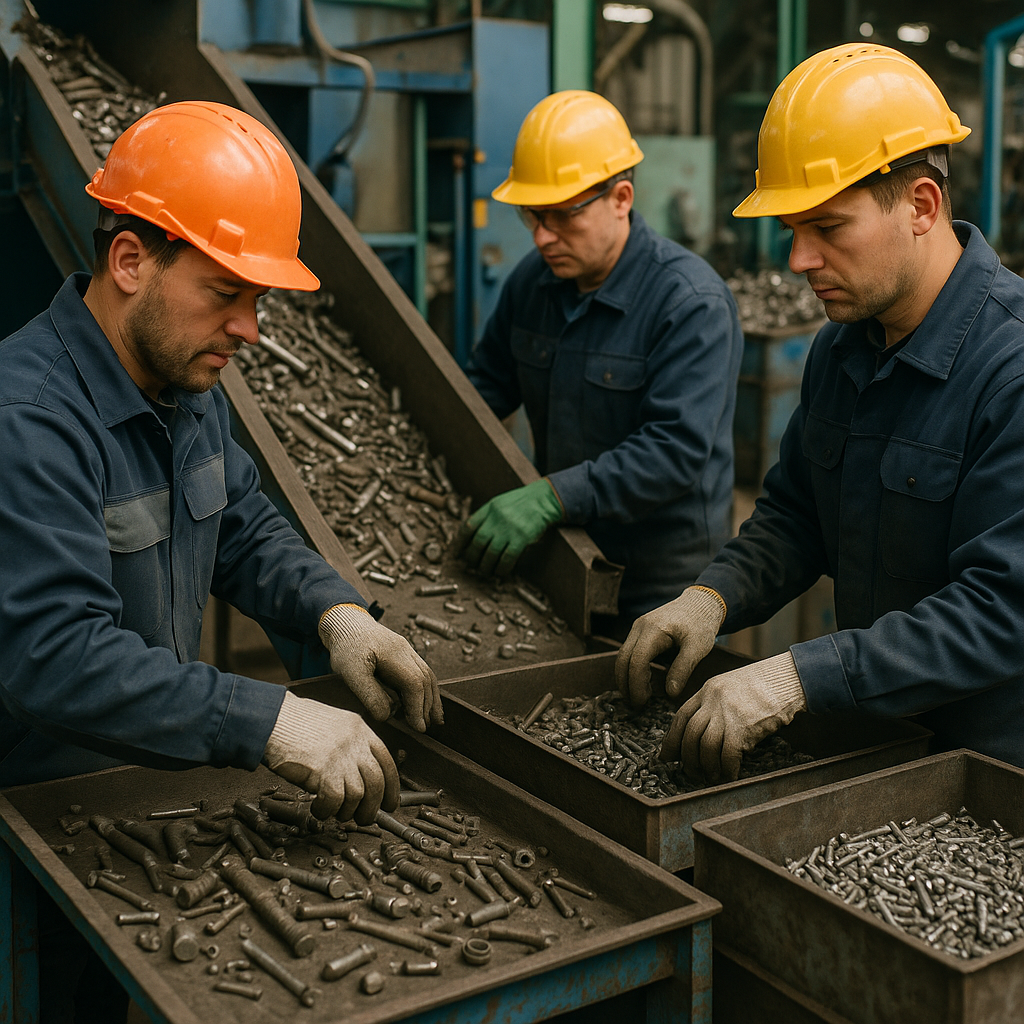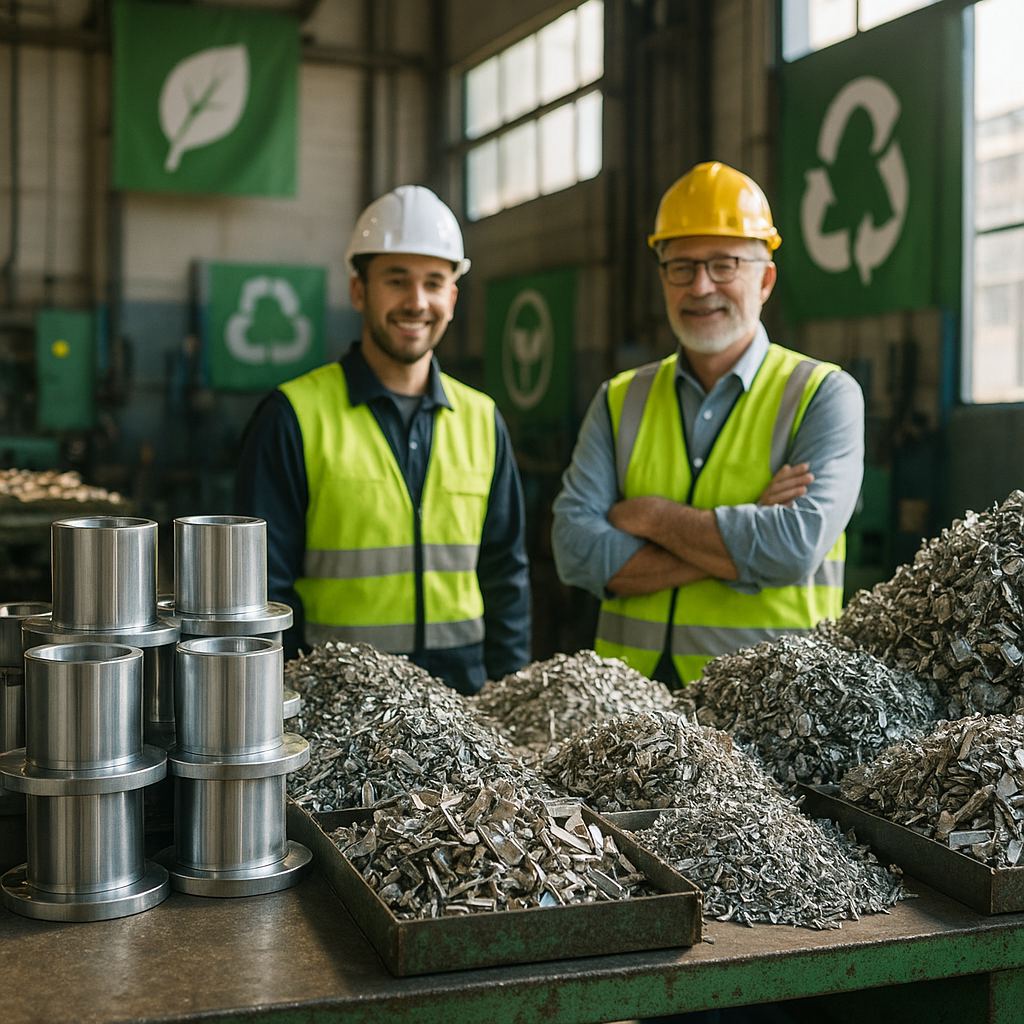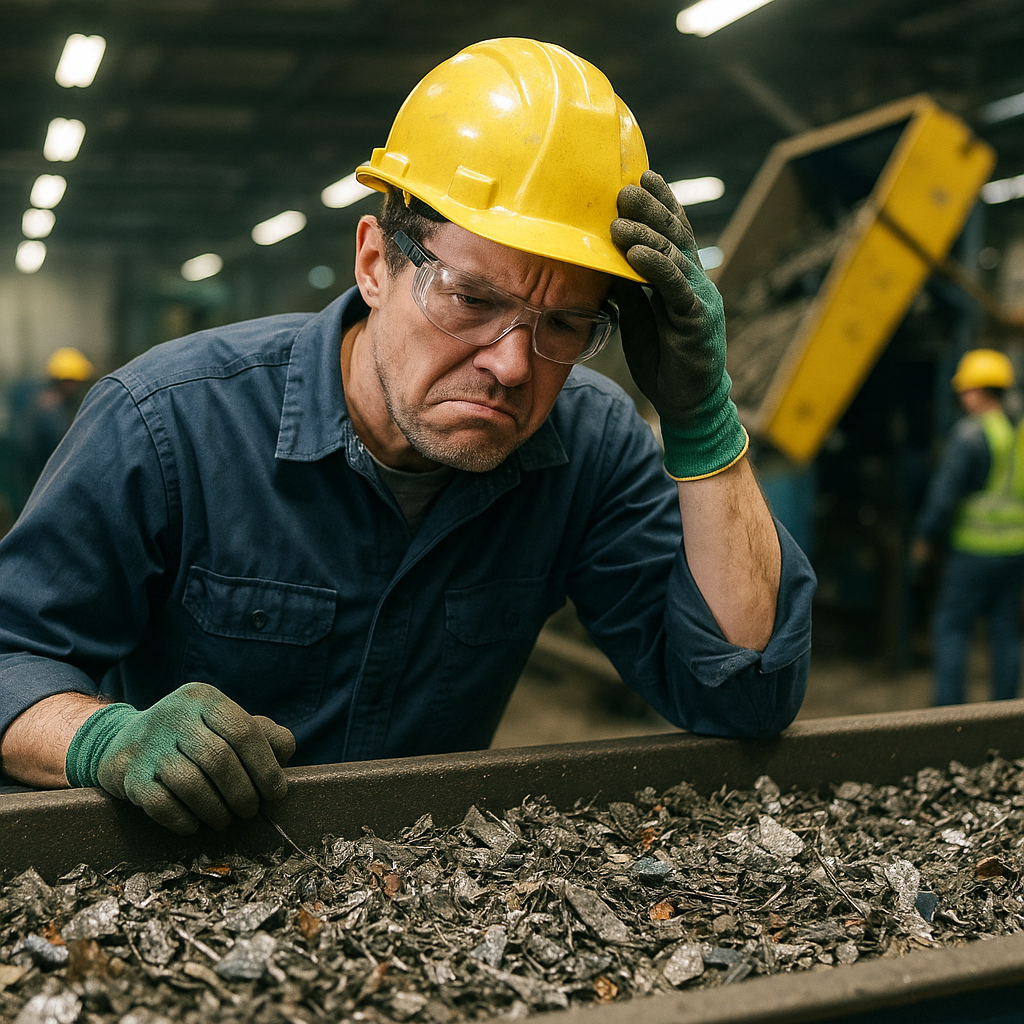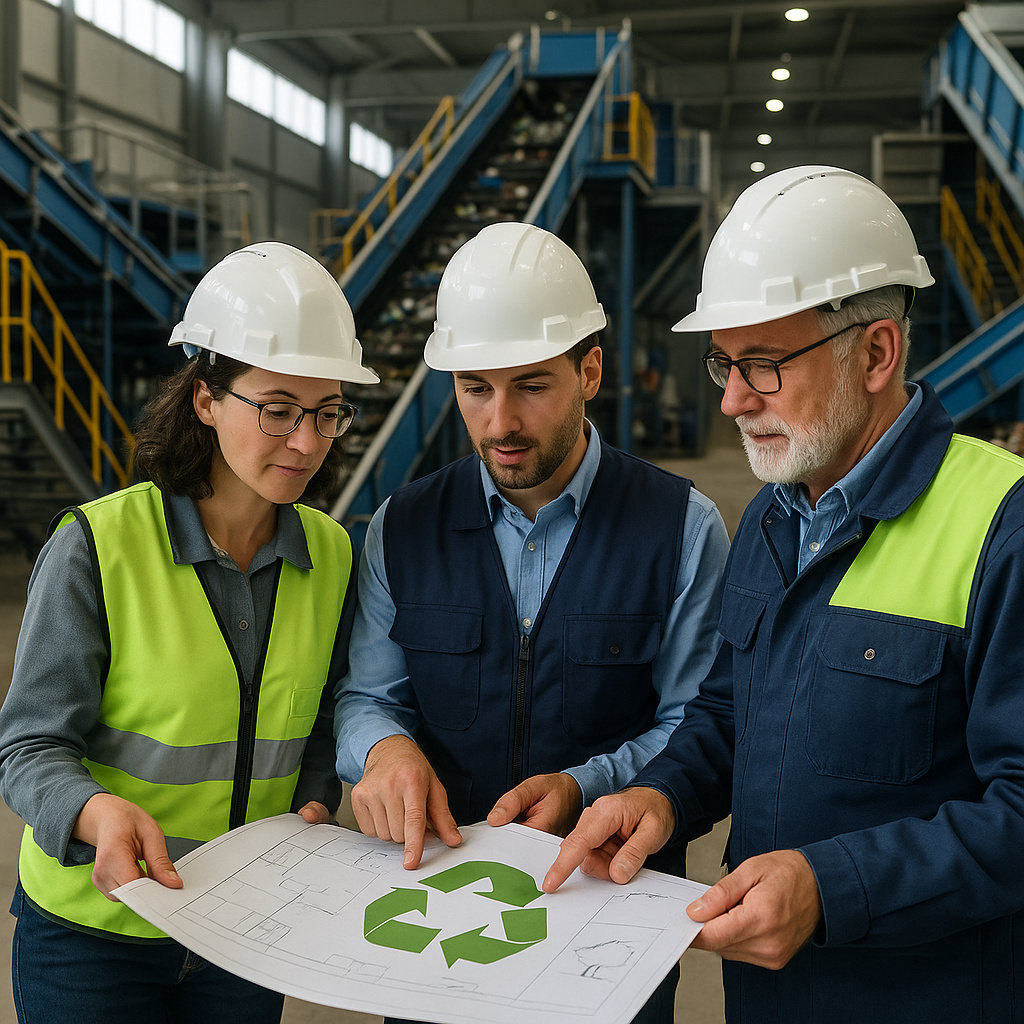5901 Botham Jean Blvd, Dallas, TX 75215
Closed-Loop Metal Recycling: Process, Benefits, and Future of Sustainable Manufacturing
October 11, 2025Closed-loop metal recycling is a manufacturing process that transforms used metal products back into the same products without quality degradation. Unlike traditional recycling methods, this sustainable approach creates a continuous cycle where materials never become waste. The system is designed to keep valuable metals circulating in the economy indefinitely.
This process differs from open-loop recycling, where materials typically get downcycled into lower-quality products. With metals like aluminum and steel, closed-loop recycling is particularly effective because these materials maintain their properties through repeated recycling cycles. A can becomes a can again, rather than being converted into a different product.
The economic and environmental benefits of closed-loop metal recycling are substantial. For aluminum, the process saves approximately 95% of the energy required to produce new metal from raw ore. Steel recycling saves about 60% of energy compared to producing virgin material. These energy savings translate directly into reduced carbon emissions and preservation of natural resources.
How Does the Closed-Loop Metal Recycling Process Work?

The closed-loop aluminum recycling process is a marvel of sustainable engineering. This efficient system transforms used aluminum cans into new ones through a series of precise steps. Unlike many materials that degrade during recycling, aluminum maintains its strength and quality regardless of how many times it cycles through the system.
Collection: The First Step Toward Sustainability
The journey begins with collection. Consumers place empty aluminum cans in recycling bins, deposit them at collection centers, or return them through deposit programs. The effectiveness of this step relies heavily on public participation, which is why some regions implement container deposit schemes with return rates reaching up to 98%.
Once collected, the cans are sorted, checked for contaminants, and compressed into dense bales for efficient transportation to recycling facilities. This preliminary organization ensures that only aluminum enters the next stages of processing.
Processing: Breaking Down for Building Up
At recycling facilities, the transformation begins in earnest. Workers break apart the bales and feed the cans into powerful shredders that reduce them to small, uniform pieces about the size of a coin. This size standardization optimizes the subsequent melting process.
Next comes the cleaning phase. The shredded pieces undergo a thermal treatment at approximately 500°C to remove paints, coatings, and other non-aluminum materials. This purification is crucial for maintaining the quality of the final product.
Melting: The Heart of Transformation
Clean aluminum fragments enter large furnaces where temperatures reach about 750°C—well above aluminum’s melting point. The metal transitions to liquid form, allowing any remaining impurities to separate for removal.
The energy efficiency of this process highlights one of aluminum recycling’s greatest benefits. Melting recycled aluminum requires only 5% of the energy needed to produce new aluminum from bauxite ore. This translates to significant reductions in carbon emissions and resource consumption.
| Type | Energy Consumption (MJ/kg) | Energy Savings (%) |
| Virgin Aluminum | 200-250 | 5% |
| Recycled Aluminum | 5-10 | 95% |
Manufacturing: Forming New Products
The molten aluminum flows into casting equipment where it cools and solidifies into large ingots. These ingots then move to rolling mills where they are transformed into sheets of precise thickness through hot and cold rolling processes.
Can manufacturers feed these aluminum sheets through presses that stamp out shallow cups. These cups undergo a series of transformations through rings of decreasing diameter to form the familiar can shape. After trimming, washing, and decorating, the cans receive tops and are prepared for filling.
This manufacturing phase completes the loop, producing new aluminum cans that are identical in quality to those made from virgin materials. The process demonstrates remarkable efficiency, with some recycled cans returning to store shelves in as little as 60 days.
Environmental and Economic Impact
The closed-loop aluminum can recycling system offers substantial environmental benefits. Beyond the 95% energy savings, it reduces mining impacts, conserves natural resources, and minimizes landfill waste, as aluminum cans would otherwise take centuries to decompose.
The economic advantages are equally compelling. Nearly 75% of all aluminum ever produced remains in use today thanks to recycling. This preservation of resources creates a more stable supply chain and supports thousands of jobs in the collection, processing, and manufacturing sectors.
What Are the Benefits of Closed-Loop Metal Recycling?

Closed-loop metal recycling creates a sustainable cycle where metals are continually reused without degradation in quality. This method offers notable environmental and economic advantages compared to traditional extraction and production methods.
Resource conservation is a key benefit. Recycling metals significantly reduces the need for virgin material extraction. Each ton of recycled steel conserves about 2,500 pounds of iron ore, 1,400 pounds of coal, and 120 pounds of limestone, thus protecting natural habitats from mining disruption.
Another advantage is energy savings. Manufacturing metals from recycled materials requires far less energy than using raw ores. Aluminum recycling, for instance, saves up to 95% of the energy needed for primary production from bauxite, while steel recycling conserves about 60-75% of the energy required for production from iron ore. Copper recycling reduces energy usage by about 85% compared to mining new copper.
Reducing greenhouse gas emissions also contributes to climate change mitigation. The Environmental Protection Agency states that recycling one ton of steel can prevent 1,000 to 1,500 pounds of carbon dioxide from entering the atmosphere. Recycling both steel and aluminum can decrease greenhouse gas emissions by 86% and 95%, respectively.
Water resource conservation is an often overlooked benefit. Metal recycling can reduce water use by up to 90% compared to primary production methods, which is crucial as global freshwater scarcity affects billions worldwide.
Reducing landfill waste is another benefit, as metals remain in circulation rather than being discarded. Metals in landfills take centuries to decompose and often contain harmful chemicals that can leach into soil and groundwater. Each ton of recycled metal saves substantial landfill space.
The economic impacts are also noteworthy. The metal recycling sector generates over $105 billion in annual economic activity in the United States alone, supporting around 500,000 jobs, including 150,000 in processing facilities with above-average wages. Workers earn approximately $77,000 annually in wages and benefits.
Tax revenue from the industry generates funds for essential public services, yielding about $10.3 billion annually, with $4.4 billion going to state and local governments and $6.8 billion to the federal government.
Reduced manufacturing costs provide businesses with a competitive advantage. Manufacturers using recycled metals can cut production costs by up to 33% compared to using virgin materials. These savings enhance the global competitiveness of American manufacturers while keeping consumer prices more affordable.
Supply chain resilience is strengthened by domestic scrap metal recycling, which provides a dependable secondary source of raw materials and helps manufacturers avoid price volatility and supply disruptions in primary metal markets.
The burgeoning green technology sector offers expanding market opportunities. Increasing demand for metals in electric vehicles, renewable energy infrastructure, and energy-efficient construction fuels growth across the recycling industry.
| Metal | Energy Savings (%) | Reduced CO2 Emissions | Resources Conserved |
|---|---|---|---|
| Aluminum | 95% | Reduces emissions by up to 95% | 8 tons of bauxite ore per ton recycled |
| Steel | 60%-74% | Reduces emissions by approximately 1.5 metric tons per ton of recycled steel | 74 million tons of iron ore, 32 million tons of coal, and 3 million tons of limestone saved annually |
| Copper | 85% |
What Challenges Face Closed-Loop Metal Recycling?

While closed-loop metal recycling offers significant environmental and economic benefits, several substantial challenges hinder its widespread implementation. Addressing these obstacles is essential for creating truly circular metal economies.
Material Contamination Issues
One of the major hurdles in closed-loop metal recycling is contamination. When recyclable metals contain non-metallic materials such as plastic, rubber, or hazardous substances, the quality of the recycled material is compromised. These contaminants must be separated before processing, which slows down operations and increases costs. Even small amounts of copper in aluminum, for instance, can significantly reduce corrosion resistance and other valuable properties of the recycled metal.
The complexity of modern products further complicates this issue. Many devices contain multiple types of metals and alloys bonded together in ways that make separation difficult. This cross-contamination during recycling creates material streams that require extensive dilution with virgin materials to restore their original functional properties.
Collection and Sorting Efficiency
Effective collection systems are the foundation of successful closed-loop recycling. Currently, many valuable metals are lost due to inefficient collection networks or improper disposal. Collection rates vary significantly by product type and region, with many high-value metals never entering the recycling stream.
Sorting technologies, while advancing, still struggle with identifying and separating different metal alloys accurately. The effectiveness of sorting is directly related to the purity of the recycled material. Without precise sorting, achieving true closed-loop recycling becomes nearly impossible for many metal applications.
Technical and Economic Limitations
The technological complexity of recycling certain metals presents significant challenges. Some specialized alloys require advanced recycling processes that are energy-intensive and costly. The metallurgical processes needed to recover metals while maintaining their quality require substantial investments in specialized equipment and expertise.
Economically, fluctuating market prices for recycled metals create uncertainty for recyclers. When prices for recycled metals are low, the financial incentive to invest in advanced recycling technologies diminishes. This volatility can undermine long-term planning and investment in closed-loop recycling infrastructure.
Limited Material Suitability
Not all metals are currently suitable for true closed-loop recycling. Some materials degrade during the recycling process, making it impossible to restore them to their original quality without significant inputs of virgin materials. This limitation means that many metals are downcycled into applications with lower quality requirements rather than being truly recycled in a closed loop.
Additionally, certain specialized alloys contain combinations of elements that are difficult to separate and recover efficiently. These technical limitations restrict the range of materials that can be effectively recycled in a closed-loop system.
Consumer Awareness and Participation
The success of closed-loop recycling programs depends heavily on consumer participation. Many consumers lack awareness about proper recycling practices, leading to contamination of recycling streams. Educating the public about the importance of recycling and the correct way to recycle metals is an ongoing challenge.
Consumer behavior, including the willingness to separate materials and participate in recycling programs, significantly impacts collection rates. Without strong consumer engagement, valuable materials may end up in landfills instead of being recovered and recycled.
Infrastructure and Regulatory Challenges
In many regions, the infrastructure for metal recycling is insufficient or outdated. This can result in bottlenecks, increased transportation costs, and delays in processing. Building and maintaining adequate recycling infrastructure requires significant investment and planning.
Regulatory frameworks around waste management and recycling are constantly evolving. While these regulations aim to improve sustainability, keeping up with changing requirements and compliance standards can be challenging for recyclers. Additionally, inconsistent regulations across different regions create confusion and complicate operations for global recycling companies.
Despite these challenges, closed-loop metal recycling remains a crucial component of sustainable resource management. Addressing these obstacles through innovation, investment, and collaboration across the value chain will be essential for creating truly circular metal economies that can support both environmental sustainability and economic growth.
| Challenge Category | Specific Challenges |
| Material Contamination | Non-metallic materials and hazardous substances slow operations and increase costs |
| Collection and Sorting | Inefficient networks cause valuable metals to be lost; sorting technologies struggle with different alloys |
| Technical and Economic Limitations | Specialized alloys require costly, energy-intensive processes; fluctuating market prices create financial uncertainty |
| Limited Material Suitability | Some metals degrade in quality and are downcycled; complex alloys are hard to recycle efficiently |
| Consumer Awareness and Participation | Lack of awareness about proper recycling practices; low participation in recycling programs |
| Infrastructure and Regulatory | Outdated infrastructure and evolving regulations complicate operations |
Conclusion: The Future of Closed-Loop Metal Recycling

Closed-loop metal recycling is a vital component of sustainable resource management in our resource-limited world. This process creates a continuous cycle where metals retain their value through multiple lifecycles, significantly reducing the need for virgin material extraction. This approach offers substantial environmental benefits, including cuts in carbon emissions, energy consumption, and landfill waste.
As recycling technologies advance and regulatory frameworks evolve, closed-loop metal recycling is expected to include new materials and industries. The integration of artificial intelligence, advanced sorting technologies, and improved recovery methods will further boost recycling efficiency. These innovations, along with increased corporate and consumer awareness, will strengthen the circular economy and help tackle critical resource challenges.
For your recycling needs, contact Okon Recycling at 214-717-4083. Our team can help you implement effective recycling programs that contribute to resource conservation and sustainability goals.
